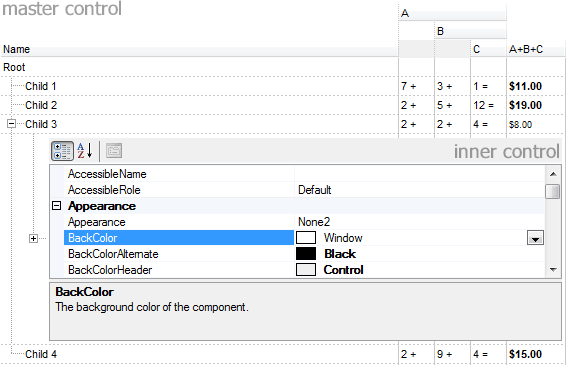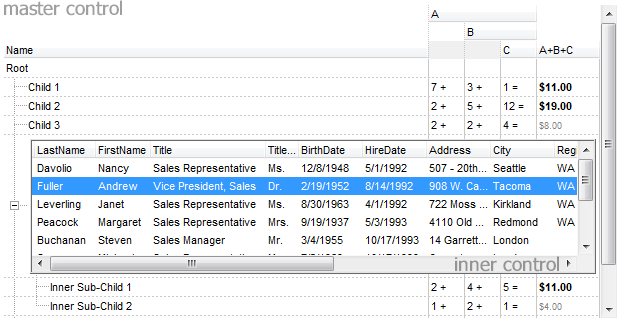- The ItemHeight property specifes the height of the item, and so the height of the hosted object.
- The ItemWidth property specifies the width of hosted object, or the position/column in the item where the object is displayed.
- The ItemAllowSizing property indicates whether the user can resize the item at runtime, and so the object being hosted.
- The ItemObject property retrieves the originally object if the item was previously created using the InsertObjectItem property, or the created ActiveX control if using the InsertControlItem property.
The following screen shot shows the /NET assembly ( master control ) that hosts a System.Windows.Forms.PropertyGrid control from the /NET framework ( inner control ):

The following samples describes:
- inserting new child item to host your object
- handing the events for the inner controls
The following VB/NET sample inserts a child item that hosts an inner exgrid/net component:
With Exgrid1
.BeginUpdate()
With .Items
Dim hx As Integer = .InsertObjectItem(.FocusItem, Nothing, New exontrol.EXGRIDLib.exgrid())
If (hx <> 0) Then
With .get_ItemObject(hx)
.BeginUpdate()
.Columns.Add("inner column")
.Items.AddItem("inner item")
.EndUpdate()
End With
End If
End With
.EndUpdate()
End With
The following C# sample inserts a child item that hosts an inner exgrid/net component:
exgrid1.BeginUpdate();
int hx = exgrid1.Items.InsertObjectItem(exgrid1.Items.FocusItem, null, new exontrol.EXGRIDLib.exgrid());
if ( hx != 0 )
{
exontrol.EXGRIDLib.exgrid innerGrid = exgrid1.Items.get_ItemObject(hx) as exontrol.EXGRIDLib.exgrid;
if ( innerGrid != null )
{
innerGrid.BeginUpdate();
innerGrid.Columns.Add("inner column");
innerGrid.Items.AddItem("inner item");
innerGrid.EndUpdate();
}
}
exgrid1.EndUpdate();
The following screen shot shows the /NET assembly ( master control ) that hosts another /NET assembly control ( inner control ):

The following VB/NET sample inserts a child item that hosts an inner System.Windows.Forms.PropertyGrid component from the /NET framework:
With Exgrid1
.BeginUpdate()
With .Items
Dim hx As Integer = .InsertObjectItem(.FocusItem, Nothing, New System.Windows.Forms.PropertyGrid())
If (hx <> 0) Then
With .get_ItemObject(hx)
.SelectedObject = Exgrid1
End With
End If
End With
.EndUpdate()
End With
The following C# sample inserts a child item that hosts an inner System.Windows.Forms.PropertyGrid component from the /NET framework:
exgrid1.BeginUpdate();
int hx = exgrid1.Items.InsertObjectItem(exgrid1.Items.FocusItem, null, new System.Windows.Forms.PropertyGrid());
if ( hx != 0 )
{
System.Windows.Forms.PropertyGrid innerPropertyGrid = exgrid1.Items.get_ItemObject(hx) as System.Windows.Forms.PropertyGrid;
if (innerPropertyGrid != null)
innerPropertyGrid.SelectedObject = exgrid1;
}
exgrid1.EndUpdate();
You can handle the events for the inner controls as you would do if they has been placed to a form or dialog.
In C# you have to use the += operator while in VB/NET you can use the AddHandler as shown in the following samples:
The following VB/NET sample adds a handler for the DblClick event:
' innerGrid_DblClick handles event for the inner grid, where the sender is the object iself
AddHandler innerGrid.DblClick, AddressOf innerGrid_DblClick
Private Sub innerGrid_DblClick(ByVal sender As Object, ByVal Shift As Short, ByVal X As Integer, ByVal Y As Integer)
MessageBox.Show("innergrid dbl click")
End Sub
The following C# sample adds a handler for the DblClick event:
// innerGrid_DblClick handles event for the inner grid, where the sender is the object iself
innerGrid.DblClick += new exontrol.EXGRIDLib.exgrid.DblClickEventHandler(innerGrid_DblClick);
void innerGrid_DblClick(object sender, short Shift, int X, int Y)
{
MessageBox.Show("innergrid dbl click");
}
The sender parameter of the event identifies the object itself that fired the event, so you can use the handler for multiple instances of the same type. The sender will make the distinction. Now, in case you want to identify actually the item in the master control that hosts the sender, you can use the FindItemData property and set the UserData parameter of the InsertObjectItem property the same as for the Obj parameter. This way the FindItemData(sender) will indicates the handle of the hosts the sender. In this case inserting the inner control should look like follows:
VB/NET
With Exgrid1
.BeginUpdate()
With .Items
Dim innerGrid As exontrol.EXGRIDLib.exgrid = New exontrol.EXGRIDLib.exgrid()
Dim hx As Integer = .InsertObjectItem(.FocusItem, innerGrid, innerGrid)
If (hx <> 0) Then
With innerGrid
.BeginUpdate()
.Columns.Add("inner column")
.Items.AddItem("inner item")
.EndUpdate()
End With
End If
AddHandler innerGrid.DblClick, AddressOf innerGrid_DblClick
End With
.EndUpdate()
End With
C#
exgrid1.BeginUpdate();
exontrol.EXGRIDLib.exgrid innerGrid = new exontrol.EXGRIDLib.exgrid();
int hx = exgrid1.Items.InsertObjectItem(exgrid1.Items.FocusItem, innerGrid, innerGrid);
if (hx != 0)
{
innerGrid.BeginUpdate();
innerGrid.Columns.Add("inner column");
innerGrid.Items.AddItem("inner item");
innerGrid.EndUpdate();
}
innerGrid.DblClick += new exontrol.EXGRIDLib.exgrid.DblClickEventHandler(innerGrid_DblClick);
exgrid1.EndUpdate();

